Important tool updates - Learn more
- Learn
-
Articles
Read about influencer marketing
-
Growthnotes - Newsletter
Insights for the modern marketer
With over 2.5 billion monthly users, YouTube is where audiences discover, engage, and buy. But every five seconds, a viewer can skip your ad unless it hooks them fast.
And with so many ad formats, YouTube can either burn through your budget or help grow your brand.
In this article:
You’ll also walk away knowing which KPIs to track for each ad type to track to accelerate your video campaigns.
P.S.: Here’s a breakdown of YouTube advertising costs by format if you're budgeting your next campaign.
For mobile-first reach, YouTube Shorts are ideal; vertical video formats increase conversions per dollar.
This guide covers ad formats, funnel-fit strategies, and tactics top video marketing agencies use to help you scale ROAS with smarter, test-driven campaigns.
Video ads let you tell stories, show emotion, and demo products in seconds, which are things static display ads can’t match. They also drive a 48% higher sales rate than static display creatives.
Besides, YouTube gives you options to optimize your video advertising strategies.
For example, 44 % of top ads in 2024 broke free from rigid 15- or 30‑second formats, proving longer ads capture attention and engagement.
YouTube advertising also leverages search intent and affinity targeting. So while viewers actively explore topics they care about, you can reach them with layered interest signals.
Use that targeting power strategically.
Marketers we’ve coached usually struggle with attribution gaps, creative costs, and proving upper‑funnel ROI to higher-ups.
You may fear spending on a format that won’t deliver results.
The fix? Map ad formats to funnel stage, budget, and creative capacity.
As Google noted in the Moët & Chandon case, “message and format are intrinsically linked,” and choosing the wrong format can break the connection between your creative and your target audience.
This guide gives you a format‑by‑format playbook, with recommended KPIs, creative tips, and format‑fit scenarios.
You’ll learn how to choose formats when budgets are low, scale ad campaigns past $50,000, and measure view‑through lift.
Below, we break down each YouTube video ad format into what it is, when it works best, what KPIs to watch, and creative best practices.
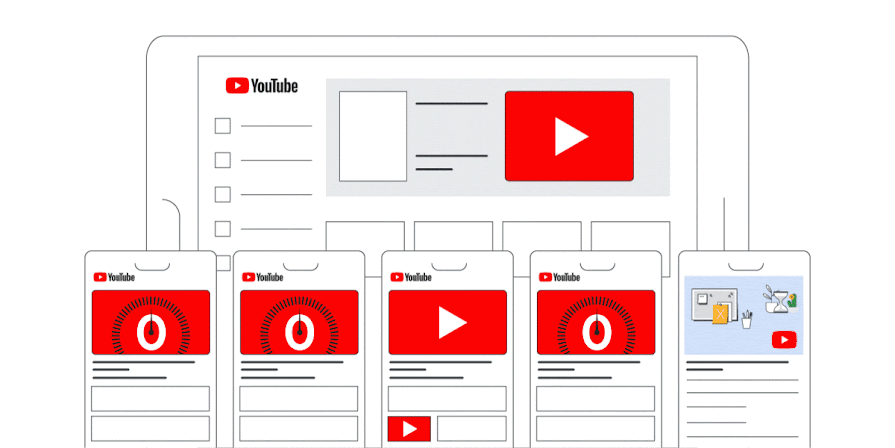
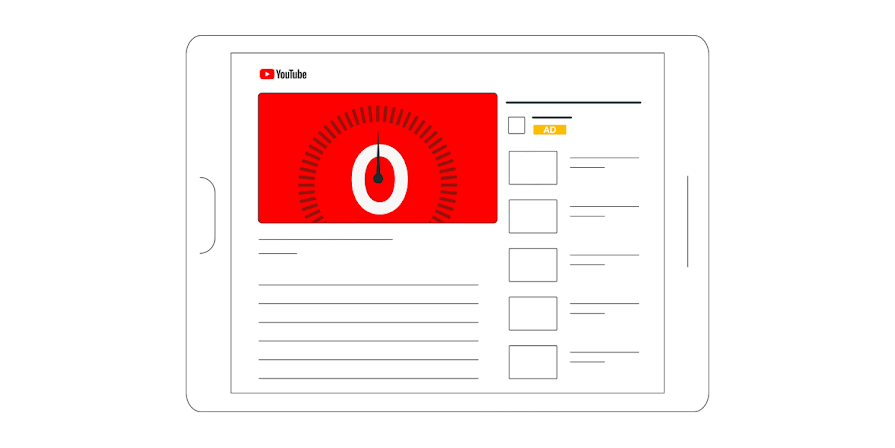
Definition & Mechanics
Skippable in‑stream ads (also known as “skippable ads” or TrueView) let viewers skip after ~5 seconds; if the ad is <30 seconds, a view counts upon completion or an interaction.
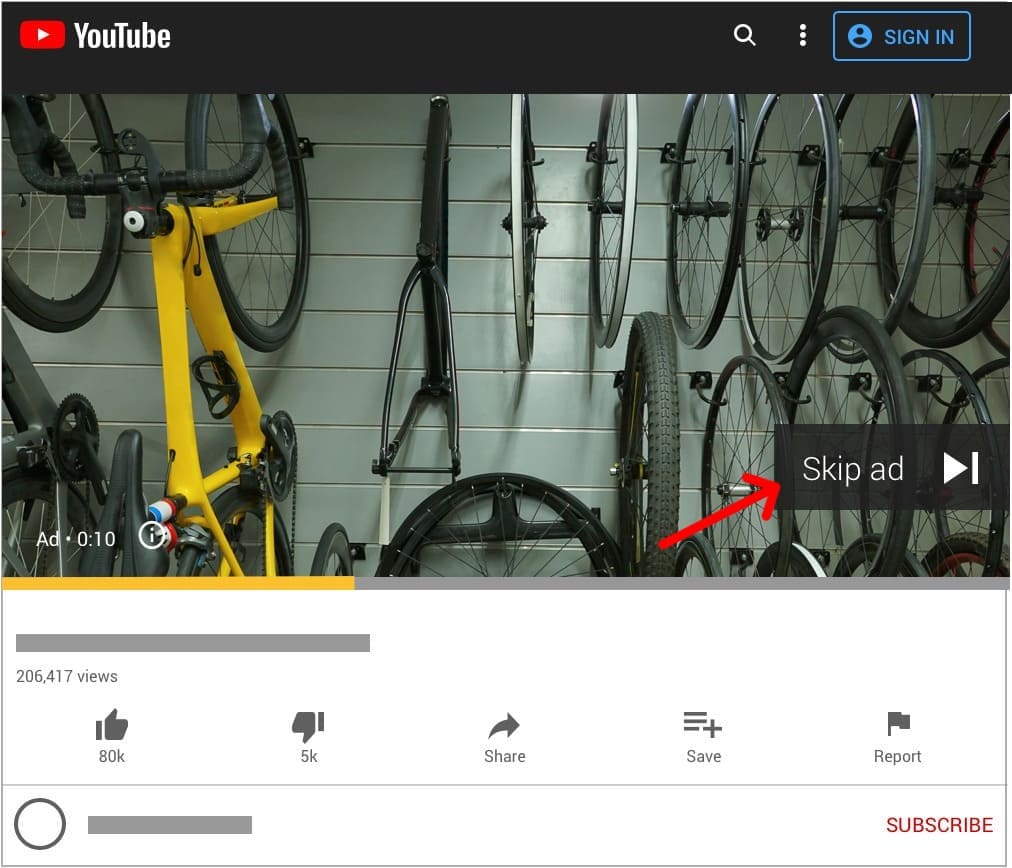
When to Use/Funnel Fit
We recommend using skippable in‑stream ads for mid-funnel consideration or as a direct‑response video campaign when you have a compelling hook.
KPIs to Track
CPV (cost per view), view rate, average watch time, view-through conversions (e.g., 7-day VTC).
Creative Tips & Tests
Lead with benefit in the first 5 seconds, using a strong CTA early. A/B test 15s vs 30s durations. We’ve seen that UGC‑marketing creatives often reduce costs and increase CTR.
Pro tip: Slice your main vertical video (e.g., from Shorts) into 15s and 30s skippable versions to test in parallel without extra shoots; we’ve seen that reusing content helps you save on production costs.
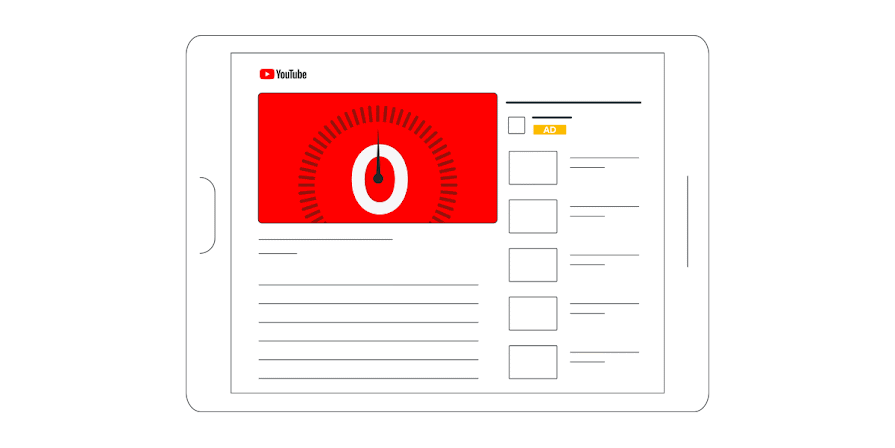
Definition & Mechanics
Depending on the region, non-skippable in-stream ads run 6–15 seconds, and must play fully (hence the name).
When to Use/Funnel Fit
They appear before, during, or after video content. Use them when you need guaranteed completion; we’ve seen them work well for brand awareness campaigns or high-impact launches.
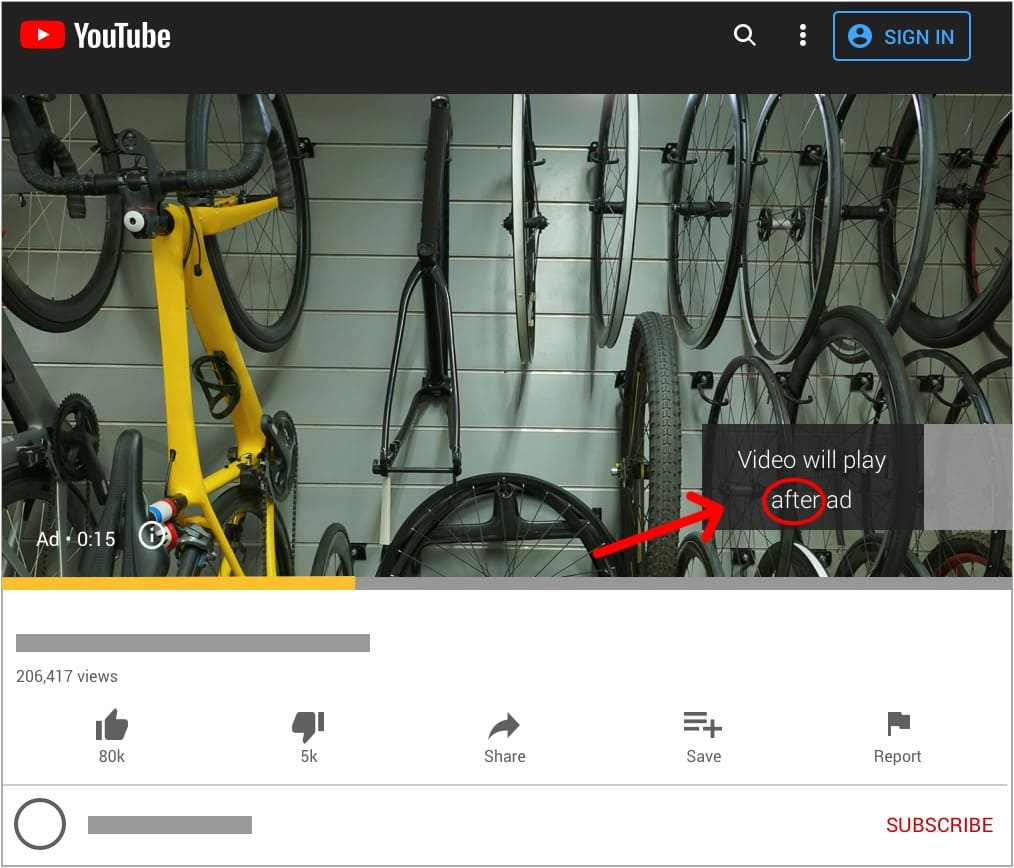
KPIs to Track
Track reach, ad recall lift, and increases in branded search queries. From our experience with non‑skippable ads, you must compress your message into one clear narrative and introduce the brand immediately. Otherwise, you risk giving your audience ad fatigue.

In-feed or Discovery ads appear in YouTube search results, Home feed, and alongside related videos on watch pages, like so:
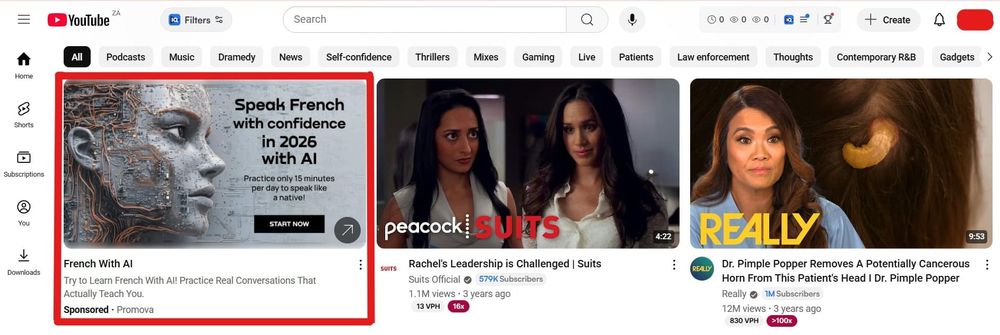
We’ve seen them work well for intent-driven discovery when users are browsing. They’re best for longer content, product demos, unboxings, or educational pieces.
Keep an eye on CTR, watch time, subscription rate, and post-view conversions.
From our experience, you should optimize the thumbnails, use benefit-led titles, and test CTAs like “Learn More” vs “Shop Now” to see what clicks with your audience.
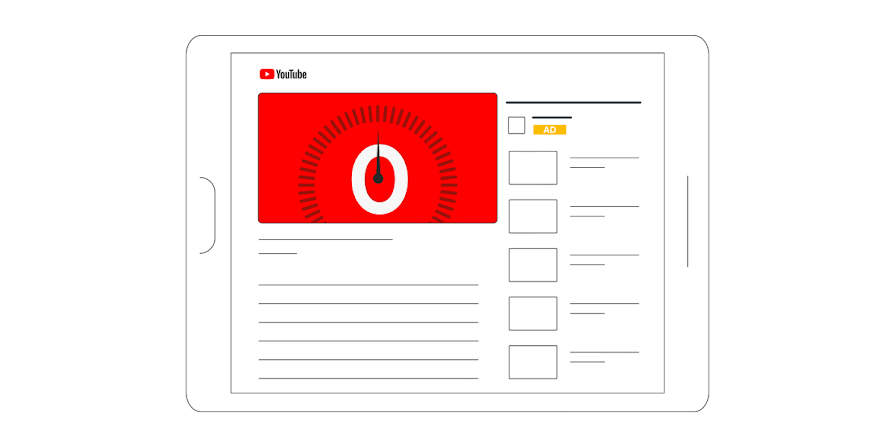
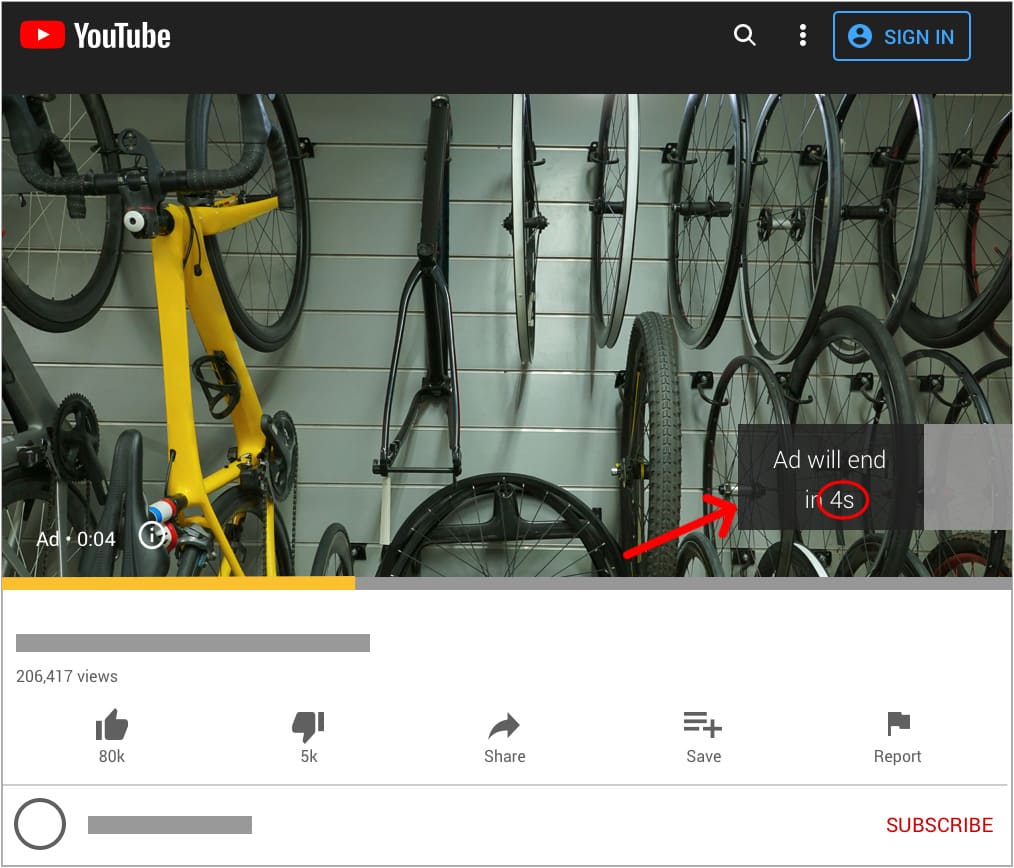
Bumper ads are 6‑second, non-skippable ads built for frequency and top‑of-funnel reach.
Use them in ad sequencing with longer ads (e.g., a bumper then a skippable). Use them in awareness or retargeting campaigns, when you want to make your product front and center.
Track reach, frequency, and brand lift metrics. In terms of creative, we recommend focusing on a single hook or visual per bumper, and repeat this across variants for consistency.
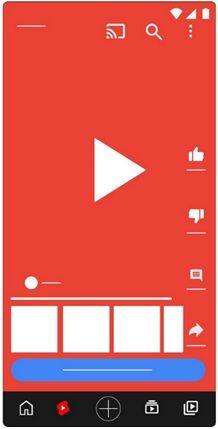
Shorts ads are vertical, mobile‑first placements embedded in Shorts feeds.
We’ve seen them work well for agile video campaigns, especially when targeting younger audiences or testing new creative ideas.
Look out for CPV, clicks, view-through conversions from Shorts, and search lift.
As shared earlier: repurpose vertical cuts of longer videos. And prioritize authenticity and fast hooks within the first three seconds: With shorter attention spans, you need to make your mark early.
As of 2025, Shorts sees ~70 billion daily views. These views have yielded impressive results: Vertical content in Shorts ads can deliver higher conversions per dollar than landscape edits in many accounts.

Masthead ads appear on YouTube’s homepage (desktop or mobile) as fixed, high-visibility inventory often sold as day buys.

They’re great for product launches, major announcements, or big-budget awareness pushes.
With this ad format, we recommend tracking unique reach, homepage impressions, and branded search lift.
Insider tip: Coordinate with other channels (email, paid media, PR) to amplify your impact, and reserve inventory early, as these premium placements often sell out during high-traffic periods.
Not sure which YouTube ad format fits your goals (or budget)? This checklist breaks it down based on your campaign goals and resources.
Decide if your goal is immediate purchase (lower-funnel), consideration, or brand lift.
Then, match your ad formats accordingly; we’ve seen that:
Segment your target audiences (prospects, engagers, site visitors) and map YouTube ad formats to each stage.
Next, use YouTube audiences and custom intent targeting in the Google Ads platform to layer precision. We recommend this, as you’ll reach the right viewers with the right message.
Check your existing assets for vertical cuts, 15-, 30-second edits, or UGC footage. If not, we recommend planning low-cost shoots or partnering with influencers through a UGC platform.
Once you have the raw content, use editing tools like CapCut or VEED to cut and repurpose video ads across formats.
Split your YouTube advertising budget by format: we’ve seen smaller accounts doing well with Shorts and Discovery.
On the other hand, larger accounts can mix masthead, non-skippable, and bumper sequencing.
Pro tip: We recommend running A/B tests (e.g., 2 creatives x 2 formats) to validate performance before scaling.
Here’s a quick breakdown of how to match YouTube ad formats to campaign objectives:
| Ad Format Options | Campaign Objective | Sample KPIs | Creative Notes |
|---|---|---|---|
| Bumper, Non-Skippable, Masthead |
Brand Awareness/Reach |
Reach, frequency, lift | One idea per ad; brand first; high frequency |
| Skippable In-Stream ads, Discovery ads |
Consideration/Engagement | View rate, watch time, CTR |
Strong hooks, thumbnails, layered CTAs |
| Skippable In-Stream ads, Shorts, Discovery |
Conversion/Lead | Conversion rate, CPA, VTC |
Crisp CTA, message alignment, retargeting funnel |
Beyond picking the right format, success depends on how you use them.
In the next sections, we’ll cover creative best practices, landing page tips, Google Ads platform integrations, and how to measure and iterate effectively for maximum impact.
Start by identifying your audience segment and how they engage on YouTube; are they passive scrollers, search-driven viewers, or loyal subscribers?
Then, match your format to that behavior.
We recommend tailoring your creative to the format: we’ve seen bold, brand-led visuals work well in bumpers; teaser-style content with strong storytelling performs well in skippable in-stream; and for Discovery ads, thumbnails, and hook-driven copy matter most.
From our experience, UGC-style ads tend to perform better in skippable and Shorts ads, while branded creative may win in non-skippable or Masthead slots.
But it’s best to test both across placements to see what clicks.
Finally, track the KPIs that matter: watch time for in-stream formats and CTR for in-feed. We believe in performance data guiding your creative decisions.
Match your ad headline, message, and offer with your landing page for a seamless user experience.
We also recommend A/B testing CTAs and form length (fewer fields = better conversion). Speed matters, too. Landing pages loading in ≤1s convert at about 31.8% (says Ecommerce Bonsai).
Each change protects conversion rates and prevents drop-offs.
For accurate attribution, link your YouTube campaigns to the Google Ads platform, GA4, and consented first-party data.
Then, track view-through conversions and UTM tags, and run lift studies to validate results. Your stakeholders will want to see these results, too.
Run weekly micro-tests on your YouTube ad formats; swap hooks, visuals, or formats. Then, refresh creative monthly. Also, pause poor performers fast and scale what works.
We’ve found that A/B testing this way gives you clean, actionable data to guide budget decisions and creative iterations without guesswork.
In 2025, you’ve got to stop treating YouTube like a money pit. We know you can win with data-driven format alignment, compelling video ads, and continuous testing.
We recommend mapping campaign goals to format, layering ad targeting, and using automation + YouTube influencer partnerships for scale. From our experience, experimentation, measurement, and flexibility win you brand growth and conversions.
Book a call with inBeat and let us help you scale your video campaigns.
There’s no one-size-fits-all. The best ad type depends on your goal, budget, and stage.
For lower-funnel conversion trackable campaigns, we recommend going with skippable in‑stream or Shorts. For top-funnel awareness, use bumpers or non‑skippable formats.
As always, test before scaling.
Your options on YouTube are endless. The site supports skippable in‑stream, non-skippable in‑stream, bumper, in-feed (Discovery) ads, Masthead ads, and Shorts ads (vertical).
Each format suits different objectives, be it reach, engagement, or conversions.
We recommend starting with a compelling hook in the first 3–5 seconds, matching the ad message to your landing page, repurposing video cuts (like repurposing a post), and testing across formats.
Use strong CTAs early and monitor format-specific KPIs, like view-through for in‑stream or CTR for Discovery.
While effectiveness depends on alignment, skippable in-stream ads are a top choice. They’re cost-efficient, drive lead generation, and amplify brand awareness by engaging viewers.
That said, skippable and Discovery ads optimize for conversions, while bumpers and non-skippable ads serve brand lift.
Not convinced? Here are some key YouTube ad benchmarks: skippable ads get ~0.5 % CTR, non-skippable run at 100 % completion but low CTR. Ultimately, your campaign objectives will be the deciding factor.